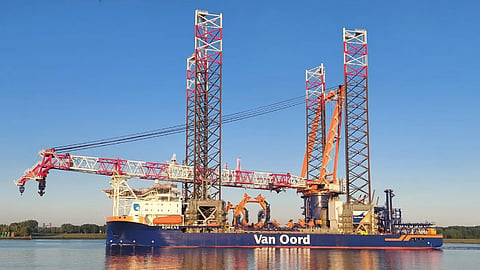VESSEL REVIEW | Boreas – Van Oord places methanol-powered installation jackup into service
Van Oord has expanded its offshore installation with the recent acquisition of a new self-elevating vessel uilt by Yantai CIMC Raffles Offshore Engineering in China.
Named Boreas after the wind god in Greek mythology, the vessel will be used primarily for the transport and installation of foundations and turbines of up to 20 MW capacity at offshore wind farms.
Significant transport and lifting capacities
The vessel has a length of 175 metres (574 feet), a 155-metre (509-foot) tall crane able to lift 3,000 tons, and four 126-metre (413-foot) legs that will permit installation works at water depths of up to 70 metres (200 feet).
The vessel relies on an open deck with a total area of 7,000 square metres (75,000 square feet) for the transport of large wind turbine components. Because a greater number of components can be carried on each voyage, the vessel can perform fewer trips in between installation activities.
The open deck can carry a maximum of 55,000 tons of assorted payloads when the platform itself is lifted to its maximum height of 70 metres above the water.
Fitted with emissions-reducing technologies
The vessel is fitted with a 6,000kWh battery pack, a dual-fuel engine that can run on methanol, and a selective catalytic reduction system to help reduce NOx emissions. The battery will be able to take peak loads and regenerate energy to reduce the vessel's fuel consumption and corresponding emissions even further.
Accommodation is available for up to 135 personnel, allowing for continuous operation for installation activities to be completed in less time.
Boreas will soon head to its first offshore wind project, the Nordseecluster development in the German North Sea. Van Oord’s scope includes the installation of 104 extended monopiles as well as scour protection.
The 1.6GW wind farm cluster is expected to generate enough renewable energy to supply the equivalent of 1.6 million German households.


